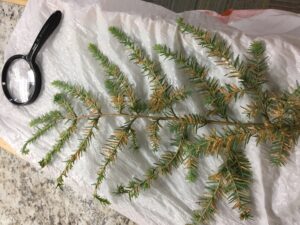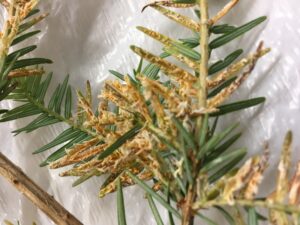Pest Alert – Hemlock Hydrangea Rust
go.ncsu.edu/readext?804637
en Español / em Português
El inglés es el idioma de control de esta página. En la medida en que haya algún conflicto entre la traducción al inglés y la traducción, el inglés prevalece.
Al hacer clic en el enlace de traducción se activa un servicio de traducción gratuito para convertir la página al español. Al igual que con cualquier traducción por Internet, la conversión no es sensible al contexto y puede que no traduzca el texto en su significado original. NC State Extension no garantiza la exactitud del texto traducido. Por favor, tenga en cuenta que algunas aplicaciones y/o servicios pueden no funcionar como se espera cuando se traducen.
Português
Inglês é o idioma de controle desta página. Na medida que haja algum conflito entre o texto original em Inglês e a tradução, o Inglês prevalece.
Ao clicar no link de tradução, um serviço gratuito de tradução será ativado para converter a página para o Português. Como em qualquer tradução pela internet, a conversão não é sensivel ao contexto e pode não ocorrer a tradução para o significado orginal. O serviço de Extensão da Carolina do Norte (NC State Extension) não garante a exatidão do texto traduzido. Por favor, observe que algumas funções ou serviços podem não funcionar como esperado após a tradução.
English
English is the controlling language of this page. To the extent there is any conflict between the English text and the translation, English controls.
Clicking on the translation link activates a free translation service to convert the page to Spanish. As with any Internet translation, the conversion is not context-sensitive and may not translate the text to its original meaning. NC State Extension does not guarantee the accuracy of the translated text. Please note that some applications and/or services may not function as expected when translated.
Collapse ▲
 Hemlock hydrangea rust is caused by the fungus Pucciniastrum hydrangeae. This rust is leaf disease of smooth hydrangea Hydrangea arborescens, in landscapes and nurseries. The fungus can also cause a minor browning and defoliation hemlocks Hemlock spp.
Hemlock hydrangea rust is caused by the fungus Pucciniastrum hydrangeae. This rust is leaf disease of smooth hydrangea Hydrangea arborescens, in landscapes and nurseries. The fungus can also cause a minor browning and defoliation hemlocks Hemlock spp.
Some rust fungi need two hosts to complete their life cycle. Apple cedar rust, Hawthorne cedar rust, White pine gooseberry rust, and Pine oak fusiform rust all need two hosts. Some rusts such as Rose rust do not need two hosts.
The first signs of rust disease in smooth hydrangea are brown/orange pustules on the underside of leaves and yellow spots on the upper side. On hemlocks, the fungus forms white to beige tendrils. The closer the plants, the easier for the fungus to complete its life cycle.
How do gardeners control hemlock hydrangea rust? Try to avoid planting these plants in close proximity. Prune shrubs to thin the plants and increase air circulation. Clean up fallen plant debris around both hemlock and hydrangea to reduce spores. Pine Sol can be used to disinfect cutting tools.





